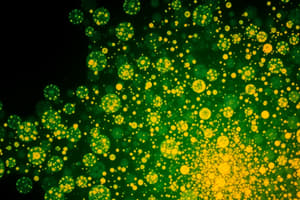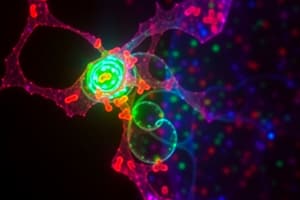Podcast
Questions and Answers
What is the main benefit of using fluorescent dyes in microscopy?
What is the main benefit of using fluorescent dyes in microscopy?
- They can only be used to color the entire cell.
- They allow for the visualization of specific molecules within cells. (correct)
- They enhance the overall brightness of the image.
- They provide a three-dimensional view of cells.
How do fluorescent substances function in fluorescence microscopy?
How do fluorescent substances function in fluorescence microscopy?
- They block certain wavelengths of light.
- They absorb and emit light at different wavelengths. (correct)
- They store energy and release it at the same wavelength.
- They increase the temperature of the specimen.
What is the role of antibodies in immunofluorescence?
What is the role of antibodies in immunofluorescence?
- They generate heat to amplify the fluorescence signal.
- They bind non-specifically to all proteins in the cell.
- They act as the source of fluorescent light.
- They specifically bind to target antigens or proteins. (correct)
What advantage does the use of multiple colors in fluorescence microscopy provide?
What advantage does the use of multiple colors in fluorescence microscopy provide?
Which statement about immunofluorescence is correct?
Which statement about immunofluorescence is correct?
Flashcards
Fluorescence Microscopy
Fluorescence Microscopy
A technique that uses fluorescent substances to visualize specific molecules within cells.
Fluorescent Substances
Fluorescent Substances
Substances that absorb light at one wavelength and emit light at a longer wavelength.
Immunofluorescence
Immunofluorescence
A technique where fluorescent dyes are attached to antibodies that bind to specific targets.
Immunofluorescence Antibodies
Immunofluorescence Antibodies
Signup and view all the flashcards
Multiple Colors in Fluorescence Microscopy
Multiple Colors in Fluorescence Microscopy
Signup and view all the flashcards
Study Notes
Fluorescence Microscopy
- Fluorescence microscopy reveals the locations of specific molecules within cells. This is done by labelling with fluorescent dyes (general) or antibodies (specific).
- Fluorescent substances absorb light of one wavelength and then emit light at a longer wavelength.
- Immunofluorescence uses a fluorescent dye instead of a coloured dye bound to an antibody. The antibody targets a specific antigen or protein. The fluorescent molecule shows the location of the antigen or protein.
- Multiple colours can be used simultaneously.
Studying That Suits You
Use AI to generate personalized quizzes and flashcards to suit your learning preferences.




